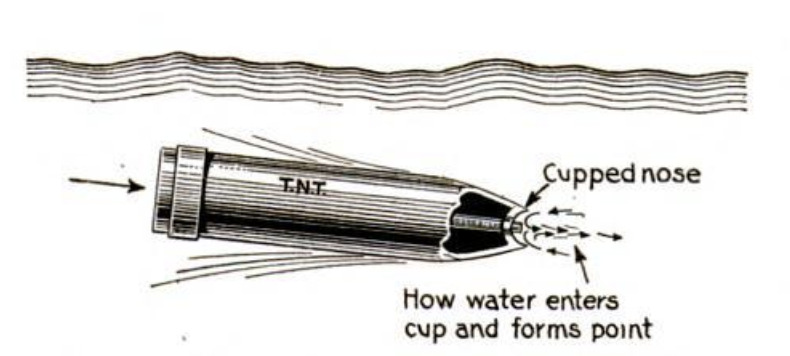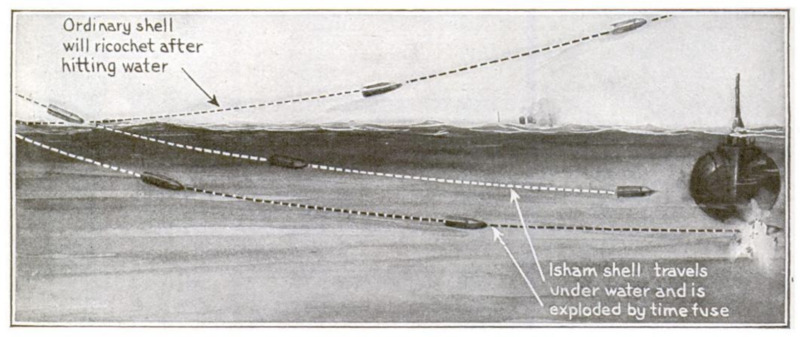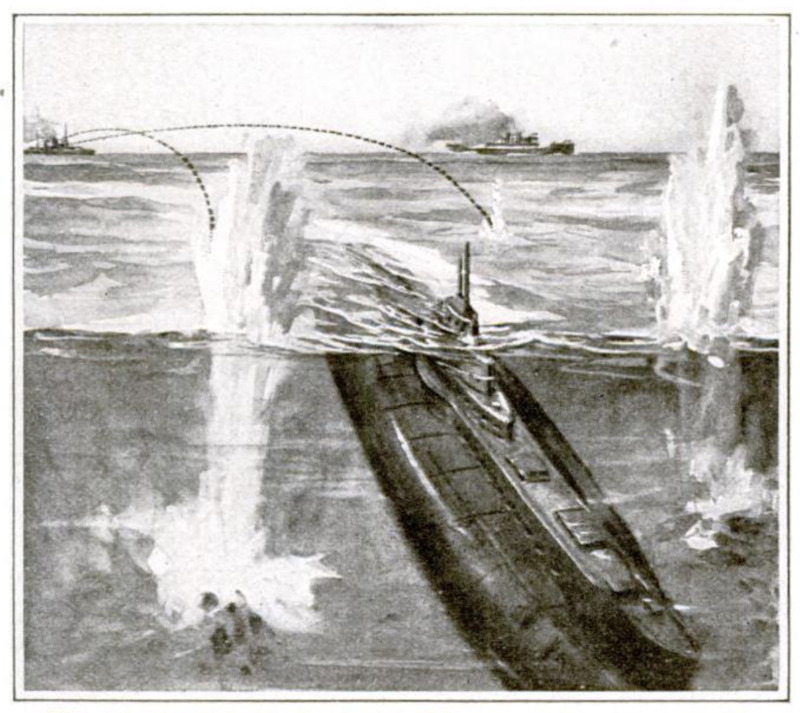Isham shell
Contenuto
-
Titolo
-
Isham shell
-
Article Title and/or Image Caption
-
Sinking U-Boats with a Sub-Sea Barrage. The Isham shell, which does not ricochet, is the latest destroyer of the submarine
-
Caption: 1: High-angle firing makes the shell strike the water at such an angle that it will dive into the sea instead of ricocheting
-
Caption 2: The explosion of the Isham shell beneath the surface is regulated automatically by a time fuse set to operate at a certain degree of submergence regardless of hydrostatic pressure
-
Caption 3: The missiles fall all about the U-boat and form a veritable subaqueous barrage—an underwater curtain of fire
-
extracted text
-
THE diving shell is the latest thing
for attacking hostile submarines.
It is the depth-
bomb improved and
therefore more po-
tent. Indeed, in the
opinion of many ex-
perts the diving shell
is the most formida-
ble instrument yet
devised for battling
with the foe's
U-boats. It is an
out-and-out Ameri-
can invention and the climax of years of
study and development on the part of
its originator, Willard S. Isham.
Of depth-bombs there are several sorts,
but of diving shells there are only two
kinds—a foreign adaptation of the Isham
missile and the Isham projectile, pure and
simple. The reason for this is that the
French and British governments have
been more alive to the merits of the Amer-
ican invention than our own ordnance
officials, and, as a result, have actually
been the first to apply the diving shell to
wartime service. We are catching up,
however, if reports from Washington can
be accepted at their face value, and the
so-called “non-ricochet shell” is likely soon
to have its place in
the magazines of all
of our destroyers
operating in
European waters.
High-Angle Fire
and Its Drawbacks
The British and
French vessels that
are armed to throw
their form of diving
shell resort to high-angle fire, the pro-
jectile traveling a course much like that
of a missile discharged from a mortar.
In this way, the shell strikes the water
at an angle sufficiently blunt to obviate
ricocheting and to insure penetration
into the sea. Once the missile has plunged
beneath the surface its explosion is auto-
matically regulated. The detonating fuse
is set to operate at a predetermined sub-
mergence as in the case of a depth-bomb.
High-angle fire from a moving craft
at an object in motion has a number of
drawbacks. First, there is the com-
paratively protracted flight of the pro-
jectile; second, its prolonged exposure
whiie in the air to the deviating sweep of
the wind; third, the fact that a slight roll
of the gun platform will greatly change the
arc of travel and, therefore, the range of
the shell; and, finally, that the target
offered by either the periscope or the
conning tower of a submarine under way
is a mark that is very hard to “range”
accurately.
These points
are mention-
ed in order
to emphasize |
the advan- |
tages of the |
Isham type
of diving or
torpedo shell
which canbe
fired over a |
flat tra-
jectory like
any ordinary |
projectile
from a naval |
gun. |
The Isham
torpedo shell |
was original-
ly intended
to attack the
under-water
bodv of an
armored ship and thus to reach her vitals.
In the invention’s present form we see a
shell especially and peculiarly suited for
battling with U-boats at long range even
though the enemy craft offer but the
smallest possible mark—the exposed tip
of a periscope. Three years ago the
Isham shell was tested by a board of
naval officers, and while the fuse did not
function satisfactorily in its entirety it
showed even then that the designer
was working in the right direction. The
projectile, however, demonstrated that
its author, by employing an unusual type
of nose, could make the shell dive, on
striking the water, and thereafter pursue
a submerged course at a gradually in-
creasing depth below the surface.
It Dives and then Explodes
The trial board reported that “a high
explosive shell is an urgent necessity for
naval use in addition to the armor-pierc-
ing shell now adopted.” And the same
commission stated:
“It would be highly desirable to have a high-
explosive shell having a fuse such as has been sug-
gested by Mr. Isham, viz, to detonate a shell on
striking thin metal, such as the side of a destroyer,
but which in striking water would not detonate until
after a period of approximately a second—this in
order that a shell vooh struck short of a ship might
continue its run under water and explode on con-
tact with the
under - water
bodyornearit.” |
Since that
time, Mr.
Isham has
developed |
a fuse that
he declares
will do all
of the fore- |
going things |
and more,
ie, it wil
explode after |
a certain
time, follow-
ing a dive,
even should
it fail to
meet an ob- |
stacle in its |
path, and if |
it hit a solid |
body, wheth-
er thick or thin, it will burst within
one hundredth of a second thereafter.
When the projectile impacts with water
the momentary checking of its speed fires
a time element or “train” of powder which |
must be consumed before the flame |
reaches the primer which actually de-
tonates the high-explosive bursting charge.
If it hits either thin or thick plating, a per-
cussion cap instantly sets off the prin-
cipal mass of high explosive. Hydrostatic |
pressure does not interfere with the
functioning of the fuse. The moment a
submarine is seen from afar, the gun will
be loaded with the Isham projectiles and
hurled at the foe, the missiles forming a |
veritable subaqueous barrage and creating
an under-water curtain fire one or two
hundred feet short of the target, so that
the shells may strike the body of the |
submarine and explode or, failing in this, |
be detonated like so many mines near
by and wreck the undersea craft.
-
Autore secondario
-
Robert G. Skerrett (writer)
-
Willard S. Isham (inventor)
-
Lingua
-
eng
-
Data di rilascio
-
1918-06
-
pagine
-
854-855
-
Diritti
-
Public Domain (Google digitized)
-
Archived by
-
Filippo Valle
-
Alberto Bordignon (Supervisor)






